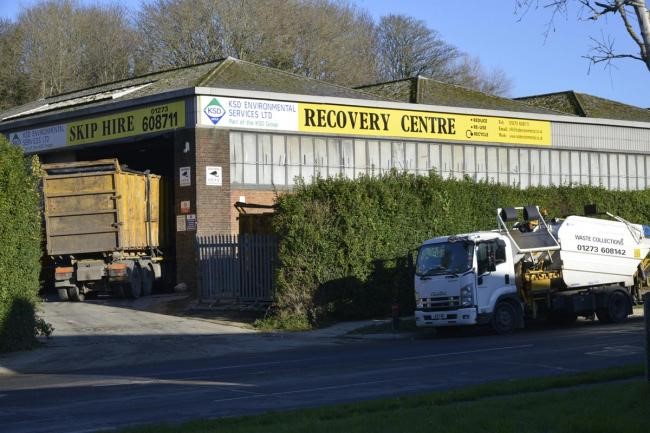Plans to build almost 400 student flats in a building up to seven storeys high in Brighton have split a community.
The scheme, proposed by developer McLaren for One Moulsecoomb Way, includes 373 student rooms, an office and community space.
McLaren’s planning application is due to be decided by Brighton and Hove City Council’s Planning Committee next week. Officials have given the scheme their backing.
A church – St Francis of Assisi – will be demolished as well as two cottages and a recycling centre.
The scheme has attracted 64 letters of support and 15 objections as well as opposition from all three councillors who represent Moulsecoomb and Bevendean ward.
A report to the Planning Committee said that many people supporting the scheme wanted the waste recycling centre moved.
They also hope that dedicated student housing will ease pressure on family homes in the area, many of which have been turned into shared houses known as HMOs (houses in multiple occupation).
Those against the scheme have criticised the height of the proposed building and want more social housing in the area.
One supporting letter on the council’s website, with the sender’s details anonymised, said: “Brighton and Hove has a severe housing crisis, exacerbated by the expansion of the two universities.
“One consequence has been the loss of family housing, not least in the Moulsecoomb, Hollingdean and Coldean areas.
“There is an urgent need for additional, specialist student housing in order to free up family homes for local people.
“Local families are being forced out of the area because of the inflationary impact caused by students occupying former family and former council housing.”
Another letter of support said: “The current use of part of this plot by the recycling company is inconvenient for residents who are affected by dust and noise from the machinery.
“The lorries coming in and out of the small yard cause a build up of traffic at a busy junction during rush hour and cross over the pavement to enter and exit the yard when many pedestrians are making their way to the school across the road as well as other workplaces on the neighbouring trading estates.”
A letter of objection said: “Any development of this land should be for social housing, not more student accommodation.
“There is already a proliferation of purpose-built student housing and the estates of Moulsecoomb and Bevendean are struggling with a high proportion of HMOs.
“This proposed development, if allowed, will add to traffic problems and will not benefit this area of Moulsecoomb.”
Another said: “I object to this application although it’s better than a waste recycling site, but as it is out of character to the listed/zoned Moulsecoomb industrial-employment estate and also not conducive to the current Moulsecoomb homes and family residential environment, where it would be wrongly located.
“It is too close to Moulsecoomb School and too close for a major high building as can be seen from residences on Bates Estate.”

One of the three ward councillors, Kate Knight, said that she had taken “numerous soundings” from residents and attended two consultations meetings before objecting to the scheme.
She said: “On each occasion grave concerns were raised about the implications of so many cars coming into the area, which already struggles to cope with parking.
“It was very clear at the most recent meeting that – aside from a suggestion that ‘green messaging’ would be employed – the developers were unable to give any assurance at all that the proposed development would be able to deliver on one of its most central commitments – namely to being car-free.”
Councillor Knight also raised residents’ concerns that Moulsecoomb was becoming a “satellite of the universities” because of the high number of students living in the area having an impact on community life and school numbers.
Fellow Labour councillor Daniel Yates said that he had heard about the positive and negative effects of the scheme and wanted to raise the unresolved issues.
He was concerned that, even though the scheme was supposed to be car-free, the developer had not explained how this would be enforced.

The loss of the recycling centre could lead to more fly-tipping in the area, with the current occupant planning to move to Newhaven.
He asked for a financial contribution from the developer to go towards improvements to the Lewes Road underpass.
If the scheme is approved, McLaren is expected to have to pay more than £500,000 in developer contributions.
Councillor Yates is a member of the Planning Committee but, given his objections to the scheme, will not take part in the decision-making next week.
The other Labour councillor for the ward, Amanda Grimshaw, said that she would also object after consulting people in the area.
The Planning Committee is due to meet next Wednesday (6 November) at Hove Town Hall. The meeting is scheduled to start at 2pm and should be open to the public.










Every time more student flats are proposed someone says they hope more family homes will be available instead of becoming HMOs. Does this
happen, it seems most unlikely to me? Landlords still want to let rooms at inflated prices and a lot of students want to live relatively unsupervised with their immediate friends, not a few hundred others.
560 unlet student rooms in HMOs at the start of the academic year according the iHowz landlord association. The HMO landscape is changing due to the proliferation of dedicated student accommodation developments. The rooms in HMO share houses are not just for students – they are available to anyone – many are used by young workers. Many are available for LHA rate, so could provide a solution to homelessness in the city.